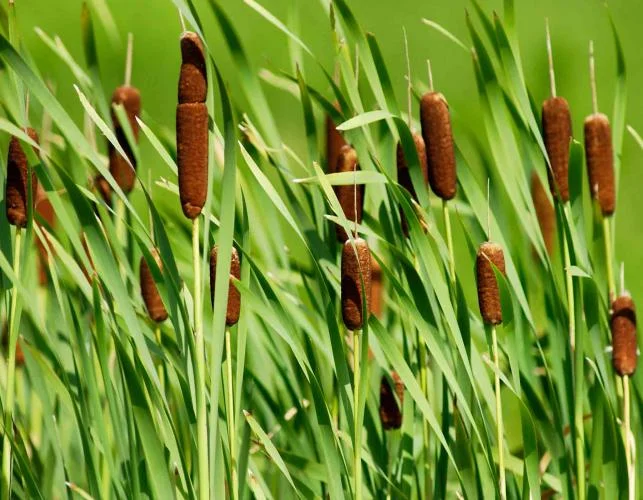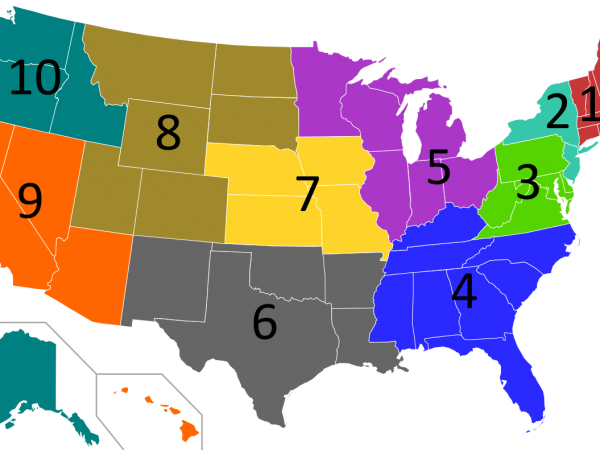
Hot dog on a stick. Water torch. Supermarket of the swamp.
Cattails go by many names, but almost everyone can recognize the pervasive wetland plant that grows along lakes, ponds, marshes, and swamps.
Their thin green stems and leaves can reach up to nearly ten feet in height. At the tippy top, their brown cylindrical flowers resemble sausages, and as these flowers mature, they burst into thousands of fuzzy white seeds like dandelions. Underneath the surface of the wet soil where cattails thrive, their thick and tuberous rhizomes sprawl the span of each cattail colony, creating a starchy underground network that anchors the plant to the damp soil.
These whimsical plants have been staples of the Great Lakes region for centuries. In a healthy wetland, birds might hide or make their nests among the foliage, and fish dart around submerged parts of the stems, to hide from predators. Other critters — including reptiles, amphibians, mammals and invertebrates — can also find shelter, food and breeding grounds amongst the cattails. Even people have benefitted from the presence of the plant: each part of the cattail is edible, and the stems, leaves and puffy seeds are valuable crafting materials.
Invasive cattails dominate about 14% of all Great Lakes coastal wetlands. Similar to other invaders of the region, these plants take up habitat space and nutrients from native plants and wildlife, leaving ecosystems unbalanced. Invasive cattails are most prevalent along the western Great Lakes, where they overrun wetlands along half of Lake Ontario and a quarter of Lake Erie.
Scientists anticipate that they’ll continue to overtake more and more of the region. Researchers and land managers are developing creative ways to deal with invasive cattails in hopes of restoring and protecting the health of the Great Lakes wetlands, but it’s not an easy task.
For starters, invasive cattails are everywhere.
“Everyone who’s alive today has grown up in the presence of this invasive plant,” said Shane Lishawa, a research ecologist at Loyola University and co-lead of Team Typha, the nation’s leading cattail research group.
Broadleaf cattails (Typha latifolia) are considered the native cattail species of the region, though any species of cattail, regardless of where it originates, can be considered invasive if it overtakes a wetland aggressively. Although any cattail can be invasive, introduced species can be especially troublesome. Since the mid-1800s, , the invasive narrow-leaved cattail (Typha angustifolia) — likely introduced from Europe — has sprawled across North America.
Cattails can reproduce asexually, which allows invaders to clone themselves and swiftly overtake large areas, but they can also reproduce sexually. When narrow-leaved cattails meet native broadleaf cattails, the two species can hybridize to create Typha x glauca, which was first recorded in the Great Lakes region in 1909.
Alberto Aleman, an evolutionary biology PhD student researching cattail genomics at Trent University, noted that these hybrids exhibit “hybrid vigor,” which means that they are especially successful invaders compared to broadleaf and narrow-leaved cattails. Hybrids can grow taller and heavier than their parent species, taking up more space than broafleaf or narrow-leaved cattails alone.
Once these hybrids pop up, they tend to stick around. Removing the plants requires expensive physical labor, and even if they are removed, they can recolonize an area quickly. Aleman explained that cattails thrive in ecosystems disturbed by land development and nutrient runoff.
“They love all the mess that we make as humans,” said Aleman.
Because invasive cattails (and human disturbances) don’t seem to be going away any time soon, researchers have been studying how exactly invasive cattails affect their surroundings in order to understand the damage. One of the most troubling aspects of invasive cattails, especially large hybrids, is that they are so bulky. While cattails’ large size allows them to store plenty of energy, they leave few resources for neighboring plants and animals.
Cattails grow in dense groups called stands, and their leaves and stems, referred to as litter, pack together above and below the waterline. The litter is hard to remove because it’s so heavy. In a single square meter, cattail biomass — the combination of all roots, flowers, stems, and leaves — can weight more than a cannonball, according to Sheel Bansal, a research ecologist at the United States Geological Survey.
In heavily colonized wetlands, the litters form walls of foliage that invertebrates and fish can’t pass through, reducing movement and animal biodiversity in the surrounding water, according to Lishawa. Additionally, cattail overgrowth makes it difficult for shorter plants to grow by blocking access to nutrients and sunlight.
This reduction spells trouble for the area’s health. Biodiversity is essential for healthy wetlands: it helps prevent coastal erosion, keeps water filtered and protects hundreds of species. Invasive organisms, like narrow-leaved and hybrid cattails, that interfere with energy production and species survival can threaten to destabilize these ecosystems, which can affect the stability of the Great Lakes region as a whole.
The Great Lakes are home to many important ecosystems that support both wildlife and human populations. Though no place is fully safe from the far-reaching effects of climate change, the region is anticipated to become a climate refuge — due to an abundance of fresh water. So, finding effective solutions to invasive cattail overgrowth could help keep the region more resilient as climates warm.
Scientists like the members of Team Typha are searching for those solutions. Over the past 70 years, researchers have tested multiple management tools — mowing, herbicides, livestock grazing, controlled burns, flooding and even explosives — but no technique is perfect. While herbicides can stop cattails from growing, they don’t remove the dense litter from the area without extra labor. Prescribed burns might reduce litter, but they don’t always eliminate below-ground components of the plants.
One of Lishawa’s most recent cattail management research projects focused on harvesting — cutting down cattail litter at the waterline and removing it from the area. Last summer, his team studied a new spin on harvesting: creating aquatic channels. They removed small chunks of invasive cattails along Northern Michigan coastlines so critters could swim through the litter, moving from coastline water to open lake water.
Compared to standard harvesting, channels allowed more native plants to grow and attracted more open-water fish, invertebrates, and amphibians, suggesting that managers could use standard harvesting and aquatic channels in tandem to encourage the most species richness. Importantly, the results confirmed that ecosystem balance can improve without eliminating invasive cattails entirely. Elimination, according to Lishawa, isn’t the goal.
“We’re not going to effectively eradicate this species,” Lishawa explained, referencing the plants’ omnipresence.
Bansal, who has collaborated with Lishawa in the past, agreed that eradication is unlikely. Since completely eliminating invasive cattails isn’t an option, managers must consider how many cattails to remove and when to do it. Bansal is interested in developing data-driven models that can predict the impacts of potential cattail expansion or removal.
“What if we managed 10% of the cattails? Or 20%? What would that look like?” he said. “We need the models to inform management.”
Bansal is particularly interested in modeling how cattails (and their removal) might affect temperature. Although wetlands only occupy about 5% of land worldwide, they sequester over a fifth of the planet’s terrestrial carbon dioxide — a gas that is known to cause temperatures to rise when released into the atmosphere. Since cattails are so huge, they help sequester some of that carbon in their stems, leaves, and roots.
However, straw-like structures in the cattails’ stems allow methane — a gas 25 times stronger than carbon dioxide — to shoot up from the soil into the atmosphere, so the effects of cattails and their management on temperatures are unclear. Cattails are complicated organisms, and since removing them can be costly and could potentially produce unintended results, models can help managers make better informed decisions.
Bansal explained that researchers like himself, Lishawa, and Alema — must ultimately convince managers to make decisions supported by research. Currently, there is little policy that regulates invasive cattail management, but the growing body of cattail research and data might change that, he said: “Policy starts with numbers.”
Until then, Lishawa hopes to see more people thinking holistically about biodiversity, sustainability, and resilience in the Great Lakes.
“I see invasive management as part of that long term,” he said.
Catch more news at Great Lakes Now:
Your Foraging Journey: A Framework to Sustainable and Safe Practices
Featured image: Cattails. (Photo Credit: Missouri Department of Conservation Staff)




